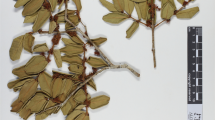Abstract
Charred flower-head remains of Carthamus tinctorius recovered from an Early Bronze Age site in northern Syria indicate that safflower was used as a dye plant. The kernels of Prunus mahaleb probably served as a flavouring agent.
Similar content being viewed by others
References
Darby WJ, Ghalioungui P, Grivetti L (1977) Food, the Gift of Osiris, 2 vols. Academic Press, London New York San Francisco
Davis P-H (ed) (1972) Flora of Turkey and the Aegean Islands, vol 4. Edinburgh University Press, Edinburgh
Germer R (1985) Flora des pharaonischen Ägypten. Philipp von Zabern, Mainz
Haezebroek M (not dated) De hedendaagse kookkunst of the wetenschap om lekker en goedkoop te eten en te drinken, 2nd edn. Van Goor, Gouda
Kroll H (1990) Saflor von Feudvar, Vojvodina. Ein Fruchtfund von Carthamus tinctorius belegt diese Färbepflanze für die Bronzezeit Jugoslawiens. Archäol Korrespondenzbl 20: 41–46
Knowles PF (1979) Safflower. In: Simmonds NW (ed.) Evolution of Crop Plants. Longman, London New York, pp 31–33
Loon MN van (1982) Hammam et-Turkman on the Balikh: background and first results of the University of Amsterdam's 1981 excavation. Akkadica 27: 30–45
Loon MN van (1983) Hammam et-Turkman on the Balikh: first results of the University of Amsterdam's 1982 excavation. Akkadica 35: 1–23
Loon MN van (ed) (1988) Hammam et-Turkman I. Report on the University of Amsterdam's 1981–1984 excavations in Syria, 2 vols. Nederlands Historisch-Archaeologisch Instituut, Istanbul
Loon MN van, Meijer DJW (1987) Hammam et-Turkman on the Balikh: first results of the University of Amsterdam's 1986 excavation. Akkadica 52: 1–9
Mouterde P (1970) Nouvelle flore du Liban et de la Syrie, tome 2. Dar el-Mashreq Editeurs, Beyrouth
Polunin O, Everard B (1976) Trees and Bushes of Europe, Oxford University Press, London
Post GE, Dinsmore JE (1932) Flora of Syria, Palestine and Sinai, 2 vols. American Press, Beirut
Schultze-Motel J (ed) (1986) Rudolf Mansfelds Verzeichnis landwirtschaftlicher und gärtnerischer Kulturpflanzen (ohne Zierpflanzen), 2nd edn, 4 vols. Akademie Verlag, Berlin
Zeist W van (in press) Archaeobotanical evidence of the Bronze Age field-weed flora of northern Syria. Diss Bot
Zeist W van, Bakker-Heeres JAH (1985(1988)) Archaeobotanical studies in the Levant. 4. Bronze Age sites on the North Syrian Euphrates. Palaeohistoria 27: 247–316.
Zeist W van, Waterbolk-van Rooijen W, Bottema S (1988) Some notes on the plant husbandry of Tell Hammam et-Turkman. Appendix 2 in: van Loon MN (ed) Hammam et-Turkman I. Report on the University of Amsterdam's 1981–1984 Excavations in Syria. Nederlands Historisch-Archaeologisch Instituut, Istanbul, pp 705–715
Zohary D, Hopf M (1988) Domestication of Plants in the Old World. Clarendon Press, Oxford
Author information
Authors and Affiliations
Rights and permissions
About this article
Cite this article
van Zeist, W., Waterbolk-van Rooijen, W. Two interesting floral finds from third millennium B.C. Tell Hammam et-Turkman, northern Syria. Veget Hist Archaebot 1, 157–161 (1992). https://doi.org/10.1007/BF00191555
Received:
Accepted:
Issue Date:
DOI: https://doi.org/10.1007/BF00191555




